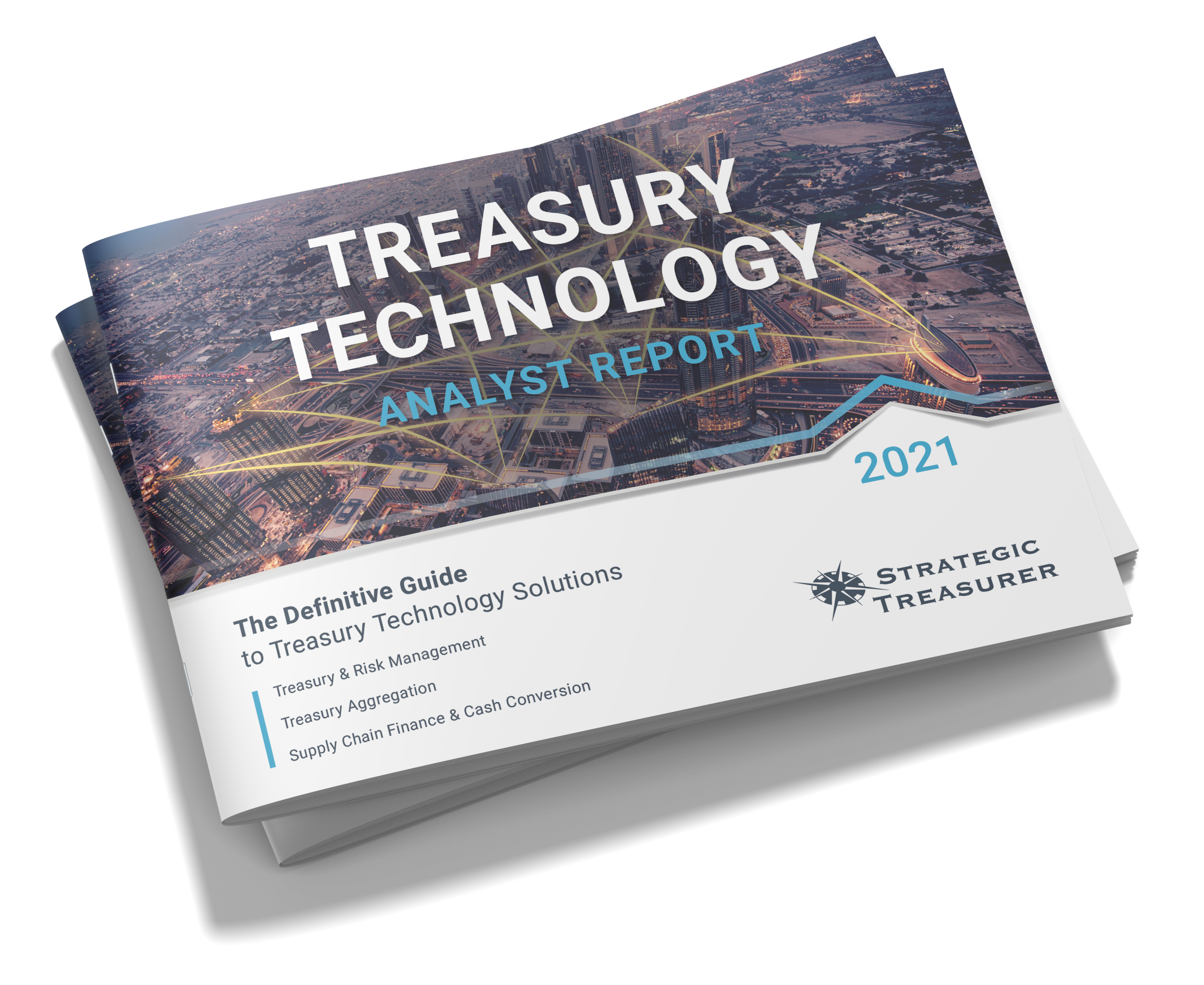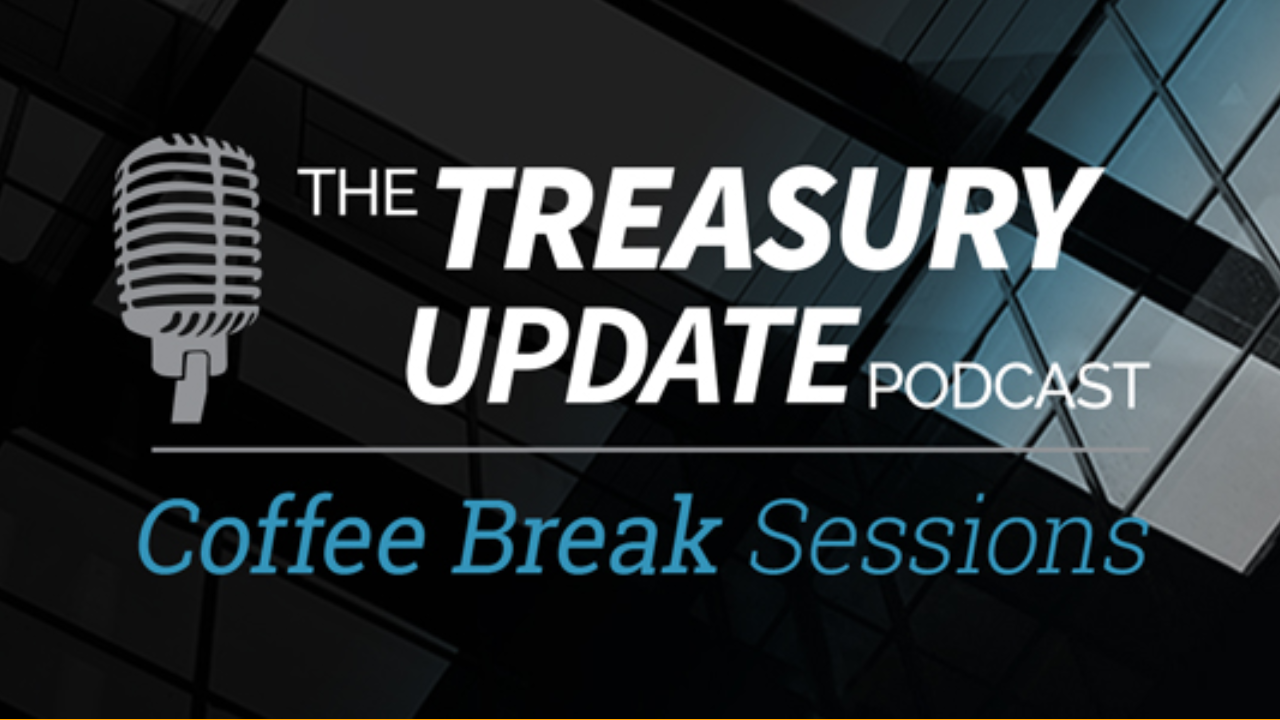
Episode 205
Weighted Average Cost of Capital
A firm’s debt and equity are important components when investors are watching. What is the cost to fund your operations? What costs are required to make investments or develop new products? In this podcast, Craig Jeffery and Paul Galloway of Strategic Treasurer discuss your WACC or Weighted Average Cost of Capital.
Host:
Craig Jeffery, Strategic Treasurer


Speaker:
Paul Galloway, Strategic Treasurer


Subscribe to the Treasury Update Podcast on your favorite app!
Episode Transcription - Episode #205 - Weighted Average Cost of Capital
Nicki Gillispie 0:03
Welcome to The Treasury Update Podcast presented by Strategic Treasurer, your source for interesting treasury news, analysis, and insights in your car, at the gym or wherever you decide to tune in.
Craig Jeffery 0:14
Welcome to The Treasury Update Podcast this is Craig Jeffrey and I am interviewing Paul Galloway. He is a senior advisor with Strategic Treasurer. And today’s topic is called Weighted Average Cost of Capital, we are going to explore some of the meanings of weighted average cost of capital for those in finances is fairly well-known term that seems to be more common than the implications of that term, how would used, where it’s used and some of the decisions that surround that. So, maybe we could start with a broader definition of weighted average cost of capital. What is that? Obviously, there’s a weighted average aspect of it and there’s a cost of capital, so maybe you could give us the definition.
Paul Galloway 0:58
Yeah, absolutely. Thanks, Craig. So, when we think about capital, there’s various sources that an organization have access to, to either raise capital or utilized capital that’s sitting on their balance sheet. So, if you want to find out where capital is, you go to the balance sheet of a company. If you want to find out what the cost of their capital is, there’s a couple of different ways to do that. One is you can go into the financial footnotes; their quarterly or annual reports and you’ll find information on any outstanding debt or other types of capital they’ve raised. If you’re an analyst out in the market, you might run some analysis around both return on equity is and find out what their cost of equity would be. These figures are important because organizations make decisions around reinvesting or distributing capital. When you do that, you can’t ignore the fact that there’s multiple sources and levers you can pull. So traditionally, people look at the weighted average cost of capital of an organization to find out what was their cost to fund their operations, to make investments, to develop new products, to distribute to investors. Weighted average cost capital simply is, let’s say your total balance sheet funding is $10 billion. Of that $10 billion, 3 billion is equity. And the rest is debt. I’m just making up numbers here. The debt components can be made up of several things. You can have senior debt, you can have medium term notes, you can have revolvers, or other fundings that you can utilize on a short-term basis. There is a cost associated with each one of those types of funding vehicles, the capital piece, you simply take the waiting this is make a simple 30% equity 70%. This is not what you would normally have, but I’m just making up numbers here. Your equity costs, let’s say 10%, and your debt costs 3%. Simply multiply 10% times 30% for equity, and that for debt 70% times 3%. And you add those two numbers together, that would give you a weighted average cost of capital.
Craig Jeffery 3:16
So, in that case, what would that be? 5.1%.
Paul Galloway 3:19
Roughly.
Craig Jeffery 3:20
Those are the elements. So, it’s the cost of overall capital, whether it’s done from equity or whether it’s done from borrowing, or you know, or debt, you know, as you tap that debt and capital markets. This is the average and so it’s weighted in that manner. So, you talked about analysts using it. So, who else uses weighted average cost of capital and what are they using it for? You alluded to, some of it for making decisions. So, maybe you could expand on that.
Paul Galloway 3:45
And one of the easiest ways I can explain it, where weighted average cost of capital come into play would be a CEOs decision on expanding their business. And they can expand their business in a couple of different ways. They could develop new products, they can reinvest in the existing platform to expand it or they can go out and buy it, and then they can execute a merger or an acquisition of some kind, or even a joint venture. There is a cost associated with doing any one of those. The cost can make a difference in terms of whether you actually decide to go through with it or not, based on what you think the return will be. So, your return that you get on the capital as investor you want to outweigh the cost of the capital you do invest. So, getting the best or most bang for your buck is important, especially from an investor perspective, but as a CEO, that’s top of mind, front of mind.
Craig Jeffery 4:47
The next question I have for you is where do you find the weighted average cost of capital? Or how do you calculate it and you said, you can look in the footnotes or you explain really what the formula is, I don’t know if there’s anything else that you would say with regarding to pulling that information or see you see where that is for your own company or for peers. Any thoughts on that?
Paul Galloway 5:07
Yeah, so that’s a great question. Some analysts have running models, or they’re getting data points from all kinds of different sources. Maybe it’s Bloomberg, maybe it’s Capital IQ or some other data source, S&P capital markets. It can be all kinds of different tools that you can utilize. You can go out and look at Yahoo Finance or Google Finance. You can find information on company, potentially fine way to average cost of capital through those sources. What I would recommend if you do that is that you trust but verify. You go you go do the research, and that’s really the best way to do it is make sure you have good information. To calculate the weighted average cost capital, calculate it yourself, doesn’t mean you can’t find out there and sources that I mentioned. But I feel like it’s always best that especially as an analyst from perspective, being an analyst or an investor, I want to do my own homework and come up with why I think is really a true cost of capital for a company before I make an investment decision in that organization.
Craig Jeffery 6:11
I want to get into a different aspect of looking at the weighted average cost of capital, if you look at the other side on the investment side, short-term yields on investments tend to be substantially lower than the weighted average cost of capital for a number of obvious reasons. When you’re evaluating either investments in activity or changes in how you run your business. There’s a way of saying what is the value in that change and some of those measures have changed in how quickly we collect funds, for example, how many more days get added if you’re making payments, etc. Why is it important to use the right rate for evaluating these different options, do you use, if I make a change in the short-term, or I make a change whether it’s short-term or long term? Does it make sense to use something like a short-term yield on investments, which might be very few basis points or under 1%? Do I use something like weighted average cost of capital in some of these scenarios? So why, first of all, why is it important to use the right rate and then we could talk about selecting the right rate for the different types of scenarios.
Paul Galloway 7:14
The reason that it’s important to select the right rate can be a combination of things that come into play. Typically, what we do in the investment arena is we look at the time horizon for a particular investment. If it’s short duration, we’re going to use shorter term rates because you want to match you want to have a matching principle where your cost of capital is matching the duration of cash flows that you’re going to invest in. If it’s shorter duration, then shorter term rates make more sense, if it’s longer duration, let’s say it’s 10 years that tenure rates make more sense. One component we hadn’t talked about yet is around rating agencies and how they treat companies. So, ratings are typically really important for organizations, and what the ratings do is assess what your credit worthiness is. And it also set the limits at which you can raise capital to fund these various projects without having a ratings downgrade.
Craig Jeffery 8:18
Let’s probe into that going past the rating agency which increases your cost of debt and capital because you’re at a lower rate forced to the decision of using one or the other you use the term the matching principle. And for those that are accounting background, the matching principle in accounting is matching revenues with the expenses that are attributed to that. So, that’s why there’s things like depreciation, you’re lining those things up so the revenue generating assets are depreciated against the revenue in some period of time. That’s one principle of what you described was the same type of principle to the matching principle matching your duration, duration of a change with the with the type of capital that you would use in call into play. I don’t know if I said that correctly.
Paul Galloway 9:09
Yeah, my prior experience I did all kinds of different analyses around, let’s take leases for instance. So, when you look at leasing something, you’re going to offset that by “Hey, what does it cost me to just flat out by it?” Typically, these lease terms are set up with various components. And part of the component is the term of the lease, and you have different options with the lease, you can have 3, 5, 7, 10-year lease, and you have various options to buy out along the way, or a lump sum at the end or just pay the whole thing off over the period. So, when we’re looking at that versus buying, I compare the cash flows for the same time periods. But I assume that there’s my cost associated with each level along the path of duration, whether it’s 3, 5, 7 or 10 years. I have certain costs associated with that. And so, you can think about underlying base rate or benchmark rate, let’s say it’s a treasury and treasury is the base or benchmark rate. Above that I add on to that a credit spread. The net credit spread is tied to duration. And my credit spread at three years is not the same as 10 years. When I match up the cost associated with the duration, that the revenues I generate, and my costs are aligned. When you look at county standpoint, in the case of this, my costs associated with making an investment in buying it or leasing it. I’m looking at them, apples to apples and that I can say which one costs less. And that’s going to tell me the story because there’s an inherent cost to capital associated with leasing that’s different than what my true cost capital is. So, I can compare the two and make a decision.
Craig Jeffery 11:01
And I think that’s, that’s a really good financial engineering model and explanation of how that how that works. Maybe I can move the discussion to an operational situation. So, you have the ability to put in some, let’s say some cash management service that either moves a particular, let’s say collection of funds back one time, and then there’s another set you can put in place you put in some service that your bank or a FinTech offers that allows you to collect your funds quite a bit sooner, let’s say five days sooner. So, all of your future flows will move five days sooner, according to what you said with a matching principle, duration, I use the term duration, but the timeframe. If I do a one-time change and moving one payment back, would you say the better rate to use for the value to the organization is reflective of a short-term investment, or effective a weighted average cost account because you’re making a change for a short period of time. What would you say for that one?
Paul Galloway 12:02
For that what you could do is duration weighted and you could say I’ve got a payment them or bring back associated cost of capital that on a weighted average basis would be that one payment compared us percentage to total payments. So, we’ll get at one payment as a percent of times this cost of capital for that short period. And then the longer duration based on your cost of capital for the full boat, and you’ve weighed that and theoretically, you will look back and say my cost of capital has declined side-to-side pay that payment sooner. That doesn’t cost me as much.
Craig Jeffery 12:37
The second part, let’s say if I move a whole stream of payments, what I do moves everything back five days, but it costs me quite a bit to put in place. You’re saying we evaluate this shift in cash flows. By five days I look at something like weighted average cost for that movement on an ongoing basis. And I compare that to my cost of doing that project. That would be more reflective, and some people are like, “Hey, let’s use the what can I earn on this money overnight”. And what you’re saying is that’s very short sighted particularly in this type of case because it’s a permanent change. As part of reflected at the beginning I think you were saying there’s alternative investments and that’s part of the stewardship thing is like, if you if you can’t earn the return, that the investors or the owners of the company want, you should return the capital.
Paul Galloway 13:26
Absolutely.
Craig Jeffery 13:27
o this is a way of making sure you’re exceeding the level and the expectation, at least of what the capital costs. Do I do this project. Yes, I’m well above weighted average cost of capital worthwhile for an economic standpoint for that and then you compare it against other projects. Is that you change how I said that or add anything to that?
Paul Galloway 13:49
I think that’s a fair assessment. You know, when you’re working in particular projects, the timing of the cash flows can make a difference. You know, in particular, especially when you’re looking at amortizing debt and you’re paying off principal. As anybody can think about if you own a house and you make your house payments, you make extra principal payments along with every other payment, guess what you’re on pay less in interest over the period and you’re paying the loan off sooner. And what that results in is a certain return back to you that you didn’t have to pay out. So, there’s value to that. In your example, moving by the 5 days sooner, can put money in the company’s pocket and so investors will look at that favorably.
Craig Jeffery 14:34
Alright, so yeah, thanks for all that input, Paul. The last question is, someone wants to learn about this portfolio in more detail, take it beyond the podcast and get into, what should our listeners do to learn more on this topic, any guidance there?
Paul Galloway 14:52
Yeah, there’s all kinds of different websites and textbooks that you can go out there and read. You can definitely do some research online on weighted average cost of capital. Also tie into that think about capital management writ large. If you tie in capital management, weighted average cost of capital those two together, I think you can find some books out there that will be really useful in explaining more in depth. And it’s certainly something that organizations have to keep an eye on. Weighted average cost of capital is constantly changing. And why is it, because equity values are changing, you’re introducing or extinguishing debt along the way over time. So, your whack is constantly moving. So, you can optimize and get to the point where you get the greatest bang for your buck today, but you know, quarter from now that can change. It can move one way or the other can cost you work because it depends on what’s going on.
Craig Jeffery 15:49
Excellent. Paul, thanks for thanks for your input. Look forward to talking about a couple other financial topics soon.
OUTRO 15:55
You’ve reached the end of another episode of The Treasury Update podcast. Be sure to follow Strategic Treasurer on LinkedIn, just search for Strategic Treasurer. This podcast is provided for informational purposes only, and statements made by Strategic Treasurer LLC on this podcast, are not intended as legal, business, consulting, or tax advice. For more information, visit and bookmark strategictreasurer.com
Related Resources
Researching new treasury and finance technology can be overwhelming. Strategic Treasurer has stepped in to help. Explore our definitive guide to the treasury technology landscape and discover detailed, data-based coverage of each area.








